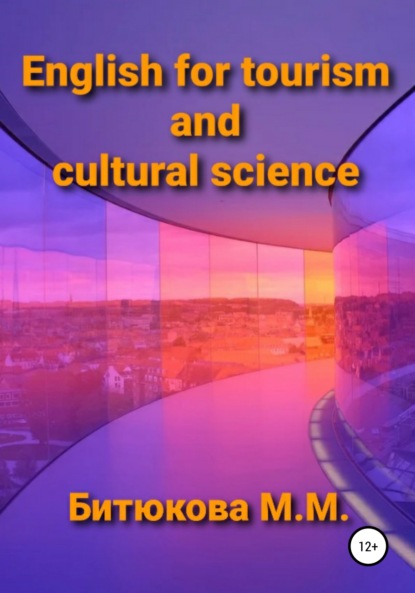
Полная версия:
English for tourism and cultural science

М. Битюкова
English for tourism and cultural science
Unit 1. Russia. Moscow
Historical Review
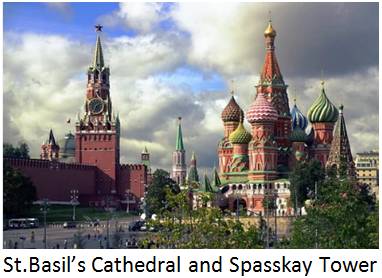
Moscow is first mentioned in chronicle under the year 1147 as a possession of Prince Yuri Dolgoruky, and this date has been taken as the year of its founding. Archaeological excavations in the centre of Moscow, however, prove that a small settlement already existed on this site as early as the 11th century.
Moscow’s position in the heart of the Russian lands and at the intersection of trade routes promoted its rapid growth. In the late 15th century the city emerged as the capital of the Russian state. The most well-known Moscow princes and kings such as grand prince Andrew Bogolubsky, Ivan Kalita, Ivan the Red, Dmitry Donskoy, Ivan the Terrible, Boris Godunov, Mikhail Feodorovich and others were the continuators of Moscow state formation.
Moscow remained Russia’s largest city even after the capital had been moved to St. Petersburg in the early 18th century.
Moscow occupied an outstanding place in the revolutionary movement. The barricades of the Krasnaya Presnya district epitomized the courage of the workers who rose in arms against tsarism during 1905-1907.
After the Great October Socialistic Revolution of 1917, Moscow was again made the capital, this time of the Russian Soviet Federative Socialist Republic and the Soviet Union less than five years later.
During the Great Patriotic War (1941-1945) the defenders of Moscow won unfading glory for themselves and the city. The great Battle of Moscow (1941-1942) resulted in the first major defeat of Hitler’s armies in World War II, inflicting on them a loss of over 400,000 men and vast amounts of combat equipment. Twenty years after the end of the war Moscow (and other twelve Soviet cities) was awarded the title of the Hero City.
The postwar period saw Moscow continuing its development as the leading political, economic, scientific and cultural centre of the country. Today it is one of the largest cities in the world (area – 2,511 sq.km.; population in 2020 – 12.4 mln. within the city limits, and over 20 mln. residents in the Moscow Metropolitan Area). It constitutes:
– a sweeping panorama of new housing projects;
– widened and straightened streets in the centre and broad new thoroughfares;
– spacious and attractive buildings of institutes and enterprises, theatres and libraries;
– sparkling window displays in shops, cafés and restaurants;
– magnificent sports stadiums and beautiful parks and gardens;
– soaring bridges across waterways;
– the marble-faced stations of the Metro.
The city symbolizes the unity of 130 large and small nations and nationalities inhabiting the Russian Federation. It is a treasure-trove of the Russian people’s culture and art; and a major tourist centre of the country.
Here the most precious historical memorials are gathered: the Moscow Kremlin, Saint Basil’s Cathedral, Novodevichy Convent, Fili Church, Moscow State University, Triumph Arch, Victory Park on Poklonnaya Hill. Revival Gates of the Kremlin with Iver God’s Mother Chapel, Kazan God’s Mother Icon Cathedral, the Cathedral of Christ the Savior have been restored and this process is going on.
Excursions
General Sightseeing Tour of Moscow (by bus, with a guide/interpreter; duration – about 3 hours). The route of this tour passes through the city’s historical centre as well as new residential areas and parks. You will be able to have a close look at the architectural features of Red Square and see the Bolshoi Theatre, meanwhile your guide will tell you about the capital’s cultural life. The bus will take you along Tverskaya street to Sadovoye Koltso (Garden Ring) and then to Novy Arbat and Kutuzov Avenue; then you will pass by the old walls of the Novodevichy Convent and move in the direction of Vorobyovy Gory (Sparrow Hills) from where you will be thrilled by a splendid panorama of Moscow. Your final stop will be at the building of Moscow State University in Vorobyovy Gory.

Moscow – a City of Sport (by bus, with a guide/interpreter; duration – 3 hours). During this excursion you will learn about the development of sports in Russia and will see palaces of sports, stadiums, major sports complexes, the Olympic Village and Luzhniki Stadium, where the opening and closing ceremonies of the 1980 Olympic Games were held, where Moscow hosted the UEFA Cup 1998-99, UEFA Champions League 2007-08 finals and the 2018 FIFA World Cup with 7 games total, including the final. You will also learn about seven horse racing tracks in Moscow, and see the largest of them – Central Moscow Hippodrome, founded in 1834.
Moscow’s Architecture (by bus, with a guide/interpreter; duration – 2.5 hours). This excursion will give you an opportunity to see some unique monuments of old Russian and modern architecture in the city. You will get acquainted with the famous Shukhov Tower which was designed by the architect Vladimir Shukhov and built between 1919 and 1922 as a transmission tower for a Russian broadcasting company; the Ostankino Tower which, when it was completed in 1967, was the tallest free-standing land structure in the world and today remains the world’s second-tallest after the CN Tower in Toronto.
Moscow and Literary Culture (by bus, with a guide/interpreter; duration – 2.5 hours). This is a tour of memorable places linked with the lives and work of outstanding Russian writers, as well as with the history of Russian literature. You will visit Moscow State Museum of Sergey Esenin, the State Museum of Vladimir Mayakovsky, the State Cultural Centre and Museum of Vladimir Vysotsky.
A Boat Trip on the Moskva River (duration – 1 hour 10 minutes). It begins at the pier near the Kiev Railway Station (Kievskaya Metro Station). Excursion boats start from the pier every thirty minutes. You will have a wonderful opportunity to see the embankment and bridges of the Moskva River and some of the city’s architectural sights.
If you are free in the evening and would like to get to know Moscow better, you can go to a “Moscow in the Evening” Tour (by bus, with a guide/interpreter; duration – 3 hours). You will see old streets and squares of Moscow, St. Basil’s Cathedral, the Moscow Kremlin, the Cathedral of Christ the Savior, Novodevichy Convent (without visiting it), the panorama of the city from Vorobyovy Gory and Poklonnaya Gora (from the bus).
The Moscow Kremlin (on foot, duration – 2 hours). The cathedrals and palaces of the Kremlin contain treasures of old art; its age-old walls have witnessed major events of Russian history. This excursion begins at Cathedral Square (Sobornaya Square) with its late 15th – and early 16th century buildings: the Annunciation, Assumption and Archangel Cathedrals, the Faceted Palace, the Bell Tower of Ivan the Great, and the Church of the Deposition of the Robe.
Organically integrated in the old architectural ensemble of the Kremlin is the Palace of Congresses, erected in 1961, where congresses of the Communist Party of the Soviet Union and other important meetings were held. In 1992 it was renamed. Now it is known as the State Kremlin Palace and is used as a theatre and for public purposes.
This excursion includes a tour of the Kremlin grounds, a visit to one of the cathedrals and a close-up view of two remarkable specimen of Russian foundry work of the 16th – 18th centuries – the Tsar-Cannon and the Tsar-Bell.
You may also visit interesting museums of the Moscow Kremlin – the Church of the Deposition of the Robe and the Patriarch’s Palace.

Around Moscow Zaryadye (on foot; duration – 2 hours). One of the oldest districts of Moscow, Zaryadye (more than 13 hectares in area) boasts a whole collection of architectural monuments of the 16th – 19th centuries such as the Old English Embassy, Church of All Saints, Roman boyar residence and some others. Together they comprise a unique open-air museum of old Russian architecture.
Around Red Square (on foot; duration – 1.5 hours). Facing the Kremlin wall, Red Square is an inseparable component of the architectural ensemble of the Kremlin. Its history dates back to the 15th century.
Here foreign tourists can visit the Lenin Mausoleum.
In the southern part of Red Square stands the exquisitely decorated Cathedral of the Intercession (better known as St. Basil’s Cathedral), a unique monument of the 16th century; facing it across the Square from the north is the History Museum, built over a hundred years ago. Opposite the Kremlin and forming the eastern boundary of Red Square is the country’s largest State Department Store – the Upper Trade Rows, known as GUM.
The only sculptured monument on the square is a bronze statue of Kuzma Minin and Dmitry Pozharsky, who helped to clear Moscow from the Polish invaders in 1612, during the Time of Troubles.
A Tour of the Moscow Metro (duration – 1.5 hours) will acquaint you with one of the world’s most beautiful and convenient underground transportation networks. Many stations of the Moscow Metro are decorated with mosaic, sculptures and stained-glass panels. Some of them are an outstanding example of socialist realist art.
Museums (in the city)
Pushkin Museum of Fine Arts. The stocks of this Museum contain fabulous collections of Babylonian and Egyptian art, of classical Greek and Roman art, and of 18th-20th century Western European paintings, works by Claude Monet, Paul Cezanne and Pablo Picasso. This museum is similar to the British Museum in London in that its halls are a cross-section of world civilizations with many plaster casts of ancient sculptures.
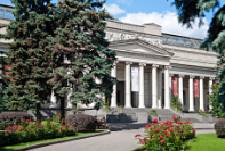
Open: daily from 10.00 am to 6.00 pm, entrance till 5.30 pm; Thursday from 1.00 pm to 9 pm, entrance till 8.30 pm.
Closed: Monday.
Tretyakov Art Gallery. A depository of works of Russian national art from the 11th century to the present. The Gallery’s collection includes 40,000 canvases, drawings and sculptures by Russian and Soviet artists. The Gallery was founded by Pavel Tretyakov (1832-1898), an eminent figure in Russian cultural life.
Open: Tuesday, Wednesday, Sunday from 10.00 am to 6.00 pm; Thursday, Friday, Saturday from 10.00 am to 9.00 pm.
Closed: Monday.
Donskoy Monastery is a remarkable example of 16th-19th century architecture, and a historical monument. You can see some fine specimens of Russian memorial sculpture and works of Russian icon-painters in the Monastery.
Andrei Rublev Museum of Early Russian Art. It has on display the rarest works of early Russian painting – icons of the 15th-17th centuries, including masterpieces by Andrei Rublev and Dionisius.
Open: Monday, Tuesday, Thursday from 2.00 pm to 9 pm; Friday, Saturday, Sunday from 11.00 am to 6.00 pm.
Closed: Wednesday.
State Museum of Oriental Art. On display there are outstanding works of art created by the peoples of the East of the former Soviet Union and Oriental countries. Among the exhibits are one of the world’s finest collections of Japanese miniature sculptures, Iranian rugs and Turkish brocade.
Open: Tuesday, Friday, Saturday, Sunday from 11.00 am to 8.00 pm; Wednesday, Thursday from 12.00 pm to 9.00 pm.
Closed: Monday.
Kolomenskoye Estate-Museum. Kolomenskoye is the site of one of the first tent-shaped stone churches built in Russia, the famous Church of the Ascension of Christ (16th century). Other exhibits include genuine early Russian wooden structures and precious collections of Russian tiles and 17th-century icons.
Open: daily from 9.00 am to 9.00 pm.
Tsaritsyno Estate is situated in the south of Moscow. It is famous for its history, its architectural monuments and its remarkably beautiful scenery. It was built especially for the great empress Catherine II. In its construction took part several generations of architects and serf masters. But the first role in the building belonged to V. Bazhenov who later engaged his student M. Kazakov to work on the drafts and to build the pavilions.
There is a museum of decorative and folk art in Tsaritsyno.
The museum is open: in winter (November – March) Wednesday, Thursday, Friday, Saturday, Sunday from 11.00 am to 5.00 pm; in summer (April – October) Wednesday, Thursday, Friday, Saturday, Sunday from 11.00 am to 6.00 pm.
Closed: Monday, Tuesday.
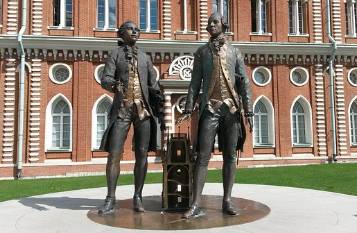
Kuskovo Estate and the Ceramics Museum. This magnificent 18th-century architectural ensemble is situated in a large park with fanciful rotundas and pavilions. The Museum has a fabulous collection of Russian porcelain, antique ceramics, as well as Chinese, Danish, English and French majolica, pottery, and glass.
Open: Wednesday, Thursday, Friday, Saturday, Sunday; November – March from 10.00 am to 4.00 pm; April – October from 10.00 am to 6.00 pm.
Closed: Monday and Tuesday; last Wednesday of each month.
Arkhangelskoye Estate is and architectural monument of the 18th-19th centuries set in picturesque surroundings 16 km from Moscow. The park, sloping down to the Moskva River, is embellished with decorative stairways, pavilions and sculptures. Near the Museum is a restaurant offering an extensive selection of Russian cuisine.
Duration of the excursion – 4 hours.
Open: daily from 10.00 am to 8.00 pm.
Closed: Monday, Tuesday; last Wednesday of each month.
Abramtsevo Estate was a meeting place for such prominent figures in Russian cultural life as Sergei Aksakov, Nikolai Gogol, Ivan Turgenev, Viktor Vasnetsov, Valentin Serov, Ilya Repin and Mikhail Vrubel. Fyodor Chaliapin took part in amateur theatrical performances staged at Abramtsevo.
Duration of the excursion – 5 hours.
Open: daily from 10.00 am to 5.00 pm.
Closed: Monday, Tuesday.
Museums (in the countryside)
Sergiyev Posad History and Art Museum-Preserve. It is situated in the town of Sergiyev Posad, which is also called “Russian Vatican”, 70 km northeast from Moscow. The Museum contains magnificent relics of Russian culture of the 14th-18th centuries and is famous by its well-known white-and-blue baroque bell tower which was one of the highest structures built in Russia in the 18th century. The Troitse-Sergiyeva Lavra (Trinity Monastery of St. Sergius), built in the 1340s, played a major role in the history of Moscow and the Russian state. The famous “Trinity” by Andrei Rublev was painted especially for the central cathedral of the Lavra.

Duration of the excursion to Sergiyev Posad – about 7 hours.
Lev Tolstoy Yasnaya Polyana Estate. It is located 12 km southwest from Tula. The great Russian writer Lev Tolstoy was born and spent most of his life at Yasnaya Polyana, and is buried there. The museum contains the writer’s mansion, the school he founded for peasant children, and a park with Tolstoy’s grave.
The excursion to Yasnaya Polyana takes 12 hours.
Excursions to the Moscow countryside should be booked, preferably well in advance, through the Service Bureau in the hotel.
Theatres
The Bolshoi Theatre was designed by famed architect Joseph Bové. Its original name was the Imperial Bolshoi Theatre of Moscow. Its opera and ballet productions are famous all over the world. Among them are Tchaikovsky’s ballets Swan Lake, Sleeping Beauty and the Nutcracker, Adam’s Giselle, Prokofiev’s Romeo and Juliet, and Khachaturian’s Spartacus; operas such as Mussorgsky’s Boris Godunov, Glinka’s A Life for the Tsar, and Rimsky-Korsakov’s The Tsar’s Bride, Borodin’s Prince Igor.
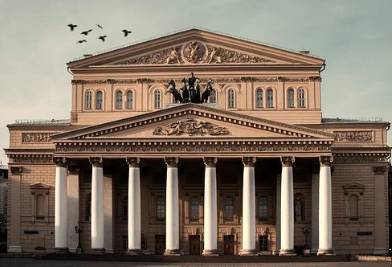
Moscow Art Theatre (MKhAT), founded in 1897 by Constantin Stanislavski and Vladimir Nemirovich-Danchenko, is famous by Anton Chekhov’s four major works, beginning with The Seagull. This play has been so firmly associated with the Moscow Art Theatre that the seagull became its emblem. In 1987, the theatre split into two troupes: Chekhov Moscow Art Theatre and Gorky Moscow Art Theatre. Oleg Tabakov was Chechov Moscow Art Theatre’s artistic director since 2000. The theatre is presently located just off Tverskaya Street, within walking distance of Red Square.
The Maly Theatre is the oldest theatre in Russia. Its company was founded by the Moscow University in 1756. The theatre’s artistic director is the national artist of the USSR, Yu.M.Solomin. The theatre’s repertoire mainly consists of Russian and world classics, especially plays by A.N.Ostrovskii. The theatre is well-known for its staging of A.K.Tolstoi’s dramatic trilogy about the history of the Russian state: Tsar Ivan Groznyy, Tsar Fedor Ioannovich and Tsar Boris. Must-sees at the Maly Theatre are Griboedov’s Gore ot uma and Pravda – khorosho, a schast’e luchshe.
The Obraztsov Puppet Theatre (formerly the State Central Puppet Theatre), founded by Sergey Obraztsov. Children and grown-ups alike love its puppet shows. Here children find themselves in the wonderful world of fairy-tales, meet their favourite characters, and enjoy the performances to the utmost.
The Moscow State Circus (on Vernadsky Prospekt) is an auditorium which was opened in 1971 and can seat up to 3,400 people. Performances are held each day in the afternoon and evening. The company employs several hundred performers and tours as the "Great Moscow State Circus troupe". The circus consists of a cast of thirty-one performers, including clowns, trapeze artists, aerial acrobats, springboard acrobats and illusionists, but does not feature animals. Since 2012 its director is Edgar Zapashny, a famous wild-animal tamer from a well-known circus dynasty.
Moscow Circus on Tsvetnoy Boulevard named after Yuri Nikulin still remains the most popular one. Among the famous performers who worked there were the clowns Karandash, Oleg Popov, and Yury Nikulin, who managed the company for fifteen years and whose name it has borne since his passing in 1997. In front of the building is a remarkable statue of Nikulin, whose son Maxim has been in charge of the circus ever since his death.
Evening performances in all Moscow theatres begin at 19:00; matinees – at 12:00. Concert and circus shows begin at 19:30.
Notes
Andrei Rublev Museum of Early Russian Art, the – Центральный музей древнерусской культуры и искусства им. Андрея Рублева
Annunciation Cathedral, the – Благовещенский собор
Archangel Cathedral, the – Архангельский собор
Assumption Cathedral, the – Успенский собор
Bell Tower of Ivan the Great, the – Колокольня Ивана Великого
Cathedral Square – Соборная Площадь
Christ the Savior Cathedral – Храм Христа Спасителя
Church of All Saints – Церковь Всех Святых (На Кулишках)
Church of the Ascension of Christ in Kolomenskoye – Церковь Вознесения в Коломенском
Church of the Deposition of the Robe, the – Церковь Ризположения
Donskoy Monastery, the – Донской монастырь
Faceted Palace, the – Грановитая палата
Fili Church – Церковь Покрова в Филях (Церковь Покрова Пресвятой Богородицы в Филях)
Grand Prince Andrew Bogolubsky – великий князь Андрей Боголюбский
Ivan the Red – Иван Красный
Ivan the Terrible – Иван Грозный
Iver God’s Mother Icon Chapel – Часовня Храма Иверской Иконы Божьей Матери
Kazan God’ Mother Icon Cathedral – Храм Казанской Иконы Божьей Матери
Kolomenskoye Estate-Museum, the – музей-усадьба Коломенское
Kuskovo Estate and the Ceramics Museum, the – усадьба Кусково и музей керамики
Moscow State University – Московский Государственный Университет имени М.В. Ломоносова (МГУ)
Museum of Oriental Art, the – музей Востока
Novodevichy Convent – Новодевичий монастырь
Old English Embassy, the – старое английское посольство
Palace of Congresses, the – Дворец Съездов
Patriarch’s Palace, the – Патриаршие палаты
Pushkin Museum of Fine Arts, the – Музей Изобразительных Искусств имени А.С. Пушкина
Roman boyar residence – Палаты бояр Романовых
Sergiev Posad History and Art Museum-Preserve, the – Историко-художественный музей-заповедник в Сергиевом Посаде
St. Basil’s Cathedral (Cathedral of the Intercession) – Храм Василия Блаженного (Покровский Собор)
State Department Store (the Upper Trade Rows) – Государственный Универсальный Магазин, ГУМ (Верхние Торговые Ряды)
Time of Troubles, the – Смутное время, или Смута (период в истории России с 1598 по 1613 год, по другим данным по 1618 год, ознаменованный стихийными бедствиями, гражданской войной, русско-польской и русско-шведской войнами, тяжелейшим государственно-политическим и социально-экономическим кризисом)
Tretyakov Art Gallery, the – Третьяковская галерея
Triumph Arch – Триумфальная Арка
Tsar-Bell, the – Царь-колокол
Tsar-Cannon, the – Царь-пушка
Victory Park on Poklonnaya Hill – Парк Победы на Поклонной горе
Vocabulary
1. A sweeping panorama of – обширная панорама чего-либо
2. A tour of memorable places – тур по памятным местам
3. A treasure-trove of culture and art – сокровищница культуры и искусства
4. An eminent figure in cultural life – выдающаяся персона в культурной жизни
5. An inseparable component of – неотделимая часть чего-либо
6. The intersection of trade routes – пересечение торговых путей
7. To acquaint smb. with smth. – знакомить кого-либо с чем-либо
8. To be booked in advance – быть заранее заказанным (зарезервированным)
9. To be embellished with – быть украшенным чем-либо
10. To be exquisitely decorated – быть изысканно (изящно) украшенным
11. To be mentioned in chronicles – быть упомянутым в летописях
12. To be set in picturesque surroundings – быть расположенным в живописном окружении
13. To be thrilled by a splendid panorama – быть взволнованным великолепной панорамой
14. To boast a collection of architectural monuments – хвастаться коллекцией архитектурных памятников
15. To comprise a unique open-air museum – составлять (включать в себя) уникальный музей на открытом воздухе
16. To contain fabulous collections – содержать поразительные (невероятные) коллекции
17. To contain treasures of old art – содержать сокровища древнего искусства
18. To enjoy the performances to the utmost – максимально (в высшей степени) наслаждаться представлениями
19. To give smb. an opportunity to see smth. – дать кому-либо возможность увидеть что-либо
20. To have a close look at – близко рассмотреть что-либо
21. To have on display the rarest works of painting – выставлять на показ редчайшие картины
22. To include a close-up view of – включать вид крупным планом на что-либо
23. To occupy an outstanding place – занимать выдающееся место
24. To play a major role – играть ведущую (значительную) роль
25. To remain smth. – оставаться чем-то
26. To rise in arms against – восстать с оружием в руках против
27. To suggest smb. do smth. – предложить кому-либо сделать что-либо
28. To symbolize the unity of some nations – символизировать единство нескольких наций



